Apply now to join our next cohort of Community Science Fellows and Community Leads!
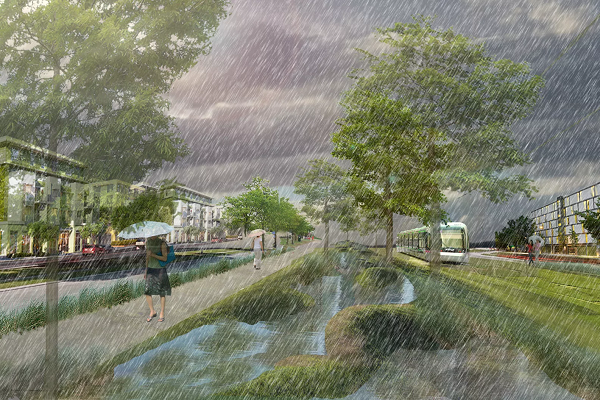
Image courtesy of Sustainia
Local organization ISeeChange worked with Thriving Earth Exchange to engage the Gentilly, New Orleans community in effective data collection and story sharing to inform flood infrastructure decision making – and build community connections through science.
Gentilly is a historic New Orleans district built on what was once the floodplains of Lake Pontchartrain. Most of Gentilly is below sea level with some areas as low as six feet. Even routine storms can cause major flooding there. The city is planning green infrastructure projects to alleviate flooding, but if the models show whole neighborhoods under water, where should they focus their efforts? Further, designers and modelers are working with data that could be outdated or lack crucial details, particularly granularity and community context. How do specific locations react to extreme rain events? How do you find out?
To answer these questions, the New Orleans ISeeChange-TEX project team designed and launched a community investigation that coupled citizen science with the stories of how community members were affected by flooding. The project, which coincided with the rainiest spring-summer on record in New Orleans, engaged residents and scientists to produce ground-truthed data (i.e. data produced by direct observation) and study the impacts of neighborhood flooding in a level of detail remote sensing and models cannot achieve.
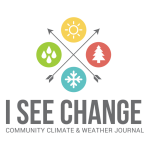 The community-led investigation was housed on the ISeeChange platform. There, residents reported observations, including detailed impacts of flooding, photographs, and precipitation totals, around their homes. ISeeChange also set up 15 flood comment boxes – with paper pop-up surveys – to recruit residents in the most flood prone neighborhoods. Within two weeks, the community reported over 158 trouble spots including several that hadn’t been previously identified. Participants also offered contact information and volunteered to help monitor flooding.
The community-led investigation was housed on the ISeeChange platform. There, residents reported observations, including detailed impacts of flooding, photographs, and precipitation totals, around their homes. ISeeChange also set up 15 flood comment boxes – with paper pop-up surveys – to recruit residents in the most flood prone neighborhoods. Within two weeks, the community reported over 158 trouble spots including several that hadn’t been previously identified. Participants also offered contact information and volunteered to help monitor flooding.
As flood posts were collected on ISeeChange’s platform, the project team analyzed the correlation between flood events and types of storms, and compared it to the city’s modeled data. The team partnered with one resident at a particularly flood-prone intersection to develop a community-sourced method to groundtruth the modeled flooding outside her home. A manual rain gauge and timelapse camera were used to document rain events and drainage rates in detail.
To complete this work, the team met bi-monthly, both in person and over the phone, to review the project objectives and develop methods. TEX project volunteers were local, able to spend time getting to know the ISeeChange team, and made site visits to the flooding hotspots to get detailed GPS measurements. In addition to the two team hydrologists, the ISeeChange team recruited and interviewed meteorologists from the National Weather Service , modelers from the Lower Mississippi River Forecast Center, water architects, and green infrastructure engineers to provide feedback on our methods, our data quality, and the value of our efforts.
The output generated by this collaboration was a co-produced methodology which enables residents to help ground truth flood maps and provide granularity that’s valuable to modelers, engineers, designers, the City and the National Weather Service. The development of these methods in sync with the deployment of HUD-funded green infrastructure investments creates baselines of flooding per storm recurrence intervals, but also presents opportunities to evaluate the impacts of stormwater mitigation efforts later. Finally, the data collection method also has the unique ability to provide qualitative details of the lived experience at scales that are often missing from models and remote sensing data.
The TEX-ISeeChange team produced a hydrograph to communicate results and presented the work several times at the American Geophysical Fall Meeting in panels, workshops, presentations, and posters. Using a mix of journalism stories, live story events, pop-up block party exhibits, and street art interventions, the results of the effort were creatively shared back to the community detailing the results.
Ultimately, the team found that the modeled flood data doesn’t adequately capture the severity of the impacts at flooding hotspots, nor does it reflect the amount of traffic that passes through the intersection. The failure of modeled data to provide the needed granularity to target solutions extends to the wider community as well. Like Gentilly residents, many New Orleans residents experience flooding during average storm events, and many streets take minutes to flood, but hours to drain.
This project has implications for scientists, planners, residents, and the City itself. The project demonstrated that scientists can directly partner with residents and external collaborators to co-develop research that is responsive to community needs and doesn’t sacrifice data quality. This project also demonstrated the effectiveness of a new methodology for engaging community members in highly contextualized observation and micro-data collection. The collection of this baseline data provides previously unavailable clarity and direction for planning agencies planning to make large investments in the neighborhood. Now, green infrastructure designers can better target solutions, as well as evaluate the impacts of stormwater projects.
Through engaging in this initiative, residents became more informed about flood risk while documenting storms – this was evident in language and data references used in posts on the ISeeChange platform.
Recognizing the value of ground truth data alongside the education and outreach value of the effort, the city has asked ISeeChange to distribute 300 rain gauges throughout New Orleans to scale out this method.
The success of the project has led the ISeeChange team to invest in new flood monitoring tool development on their platform, allowing the method to scale to new communities.
This work was time intensive. The team is now considering how can they scale up the initiative without sacrificing quality.
The relationship between ISeeChange and the Tulane Bywater Institute has strengthened on multiple fronts and the groups would welcome additional opportunities to collaborate again on local resilience projects in the City of New Orleans or on the Gulf Coast.
Things that contributed to success of the project:
Things the team might do differently if they were to do it over again:
Advice for people pursuing similar community science projects:
New Orleans Flooding Case Study (Presented at 2017 AGU Fall Meeting)
May 2018 Feature in PhysicsWorld (Video)
This project took place from May 1, 2017 – December 1, 2017. However, ISeeChange continued to conduct monitoring activities after the project period, ended to further inform flood infrastructure decisions in the community.
Gentilly is a historic New Orleans district built on what was once the floodplains of Lake Pontchartrain. Most of Gentilly is below sea level, by as much as six feet in some areas. Even routine storms can cause major flooding in the district.
The city is planning green infrastructure projects (like planting gardens and restoring natural waterfront areas) to alleviate flooding, but if the models show whole neighborhoods under water, where should they focus their efforts? How do specific locations react to extreme rain events?
Local organization ISeeChange worked with Thriving Earth Exchange researchers to design a community investigation that coupled citizen science with the stories of how community members were affected by flooding. The project engaged residents and scientists to produce data produced by direct observation, enabling them to study the impacts of neighborhood flooding at a level of detail that remote sensing and models can’t reach.
The project coincided with the rainiest spring and summer on record in New Orleans and found that modeled flood data didn’t capture the severity of the impact at flooding hotspots in the community or the impact it had on people’s movement through the community.
In combination with rain gauges and field cameras, this first-hand data gave city planners crucial information and a place to start for implementing new, community-led, climate-friendly strategies to control flooding in the district.
This included building a water garden, butterfly garden, and improved access to Gentilly’s waterfront as part of an integrated flood management system that includes green infrastructure.
ISeeChange’s mission is to connect communities to each other and their changing environment, and they provide engagement tools for communities to empower participants with their own stories and data to investigate the impacts of climate change. The organization launched a neighborhood pilot program in the Gentilly Resilience District in New Orleans to further the climate resilience and creative placemaking efforts of the Trust for Public Land, the City of New Orleans, and other resilience partners.
The flood and subsidence investigation in the Gentilly Resilience District of New Orleans informed plans for green and blue infrastructure projects to manage stormwater in the community under a multi-million dollar grant from the U.S. Department of Housing and Urban Development. This neighborhood investigation was a citizen science effort and included residents documenting their personal experiences alongside collected data (weather, temperature, etc.).
ISeeChange developed multidisciplinary project team to advise on, co-design and implement the project, including ISeeChange staff, scientific experts (e.g. subsidence and urban meteorology), local journalists and community members.
Scientists Brendan Yuill and Brendan Edwards, who engaged on this project through the Thriving Earth Exchange, collaborated with ISeeChange cofounder Julia Drapkin to inform the investigation design and contribute to the analysis of collected data and observations. Their input ensured that the information collected through this effort was actionable, scientifically valid and useful. (For another example of an ISeeChange community investigation, see their Harlem Heat project.)
As a direct result of this project, the development and analysis of the ISeeChange Gentilly Resilience District pilot project was informed by a scientific understanding of the community’s hydrology.
The ISeeChange Gentilly Resilience District pilot project facilitated the community’s participation in collecting baseline data needed to finalize and implement green and blue infrastructure designs in New Orleans, and integrated their personal experiences into the process. This not only yielded crucial observational data that flood modeling, for example, could not provide – it helped community members affected by local flooding become more connected to each other and their environment.
During AGU’s 2021 Fall Meeting in New Orleans, we were honored to meet many community members who are working to make the region’s neighborhoods healthier, more connected and more resilient. Here’s a glimpse of what we saw.
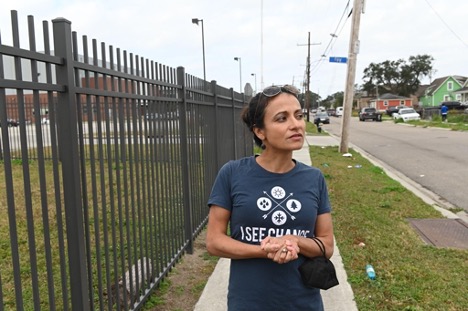 Community lead Julia Kumari Drapkin stands in front of a football field in Gentilly, now the site of a water retention project. The community-sourced data from the Gentilly Thriving Earth Exchange project was a catalyst that resulted in remodeling and reallocation of $4.8 million in flood mitigation to the St. Bernard Campus in Gentilly. The underground unit was expanded by 2.5x, storing up to 5 million gallons of stormwater in underground detention basins – the largest of its kind in the South.
Community lead Julia Kumari Drapkin stands in front of a football field in Gentilly, now the site of a water retention project. The community-sourced data from the Gentilly Thriving Earth Exchange project was a catalyst that resulted in remodeling and reallocation of $4.8 million in flood mitigation to the St. Bernard Campus in Gentilly. The underground unit was expanded by 2.5x, storing up to 5 million gallons of stormwater in underground detention basins – the largest of its kind in the South.
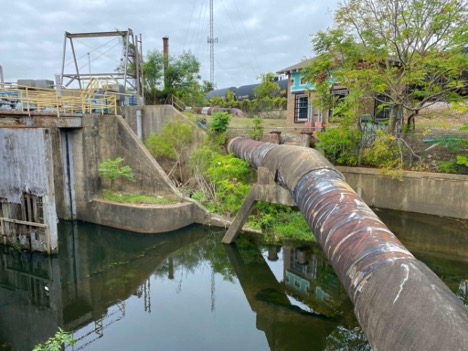 A view of Pumping Station No. 3 in the 7th Ward. Flood control infrastructure is critical in New Orleans 24/7 – there’s someone on the job at every pumping station in the city at all hours, every day, 365 days a year. Here, we see the canal and the transfer pipe that moves water out of the neighborhood and pumps it to Lake Pontchartrain.
A view of Pumping Station No. 3 in the 7th Ward. Flood control infrastructure is critical in New Orleans 24/7 – there’s someone on the job at every pumping station in the city at all hours, every day, 365 days a year. Here, we see the canal and the transfer pipe that moves water out of the neighborhood and pumps it to Lake Pontchartrain.
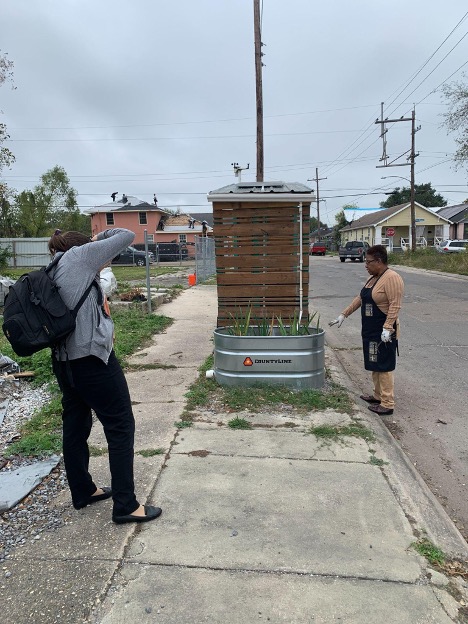 AGU Design director Beth Bagley photographs Angela Chalk, founder of Healthy Community Services, in front of a bus shelter designed with a slanted roof and rain garden to reduce flooding. It also includes a solar-powered charging station that residents can use to power up electronics – a valuable resource if power is lost due to hurricanes or other climate catastrophes. Angela Chalk served as community lead on a Thriving Earth project on monitoring the effects of greening on the urban heat island effect, water uptake, and social challenges and is serving as a Community Science Fellow on a new project in the 7th Ward.
AGU Design director Beth Bagley photographs Angela Chalk, founder of Healthy Community Services, in front of a bus shelter designed with a slanted roof and rain garden to reduce flooding. It also includes a solar-powered charging station that residents can use to power up electronics – a valuable resource if power is lost due to hurricanes or other climate catastrophes. Angela Chalk served as community lead on a Thriving Earth project on monitoring the effects of greening on the urban heat island effect, water uptake, and social challenges and is serving as a Community Science Fellow on a new project in the 7th Ward.
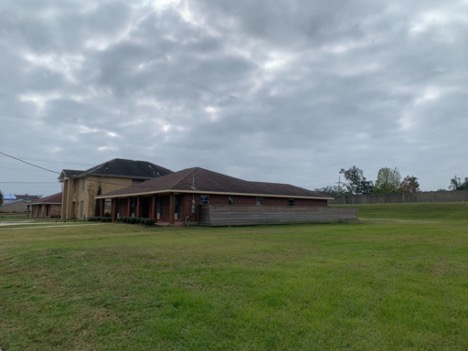 The Flooded House Museum at the breach site of the London Avenue Canal flood wall is a sobering reminder of the impacts of Hurricane Katrina. During the storm, the house was pushed across the street and turned around 180 degrees. Today, it has been returned to its original plot, and is preserved as a museum where visitors can look in through storm windows to see how the hurricane devastated its interior. The London Avenue Canal’s flood wall can be seen in the background; the wall was breached just yards from where the house stood.
The Flooded House Museum at the breach site of the London Avenue Canal flood wall is a sobering reminder of the impacts of Hurricane Katrina. During the storm, the house was pushed across the street and turned around 180 degrees. Today, it has been returned to its original plot, and is preserved as a museum where visitors can look in through storm windows to see how the hurricane devastated its interior. The London Avenue Canal’s flood wall can be seen in the background; the wall was breached just yards from where the house stood.
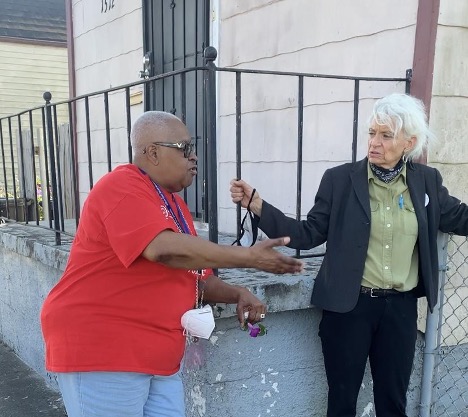 Community lead Beth Butler and resident Debra Campbell stand at the corner at the site of a future bioswale and affordable housing in New Orleans’ 8th Ward. The planned design integrates native plant gardens and private outdoor space to promote residents’ physical and mental health as part of the Thriving Earth projects Designing Bioswales for Improved Air Quality, Serenity and Reduced Flood Risk and Assessing Flooding and Hydrodynamics for Community Revitalization.
Community lead Beth Butler and resident Debra Campbell stand at the corner at the site of a future bioswale and affordable housing in New Orleans’ 8th Ward. The planned design integrates native plant gardens and private outdoor space to promote residents’ physical and mental health as part of the Thriving Earth projects Designing Bioswales for Improved Air Quality, Serenity and Reduced Flood Risk and Assessing Flooding and Hydrodynamics for Community Revitalization.
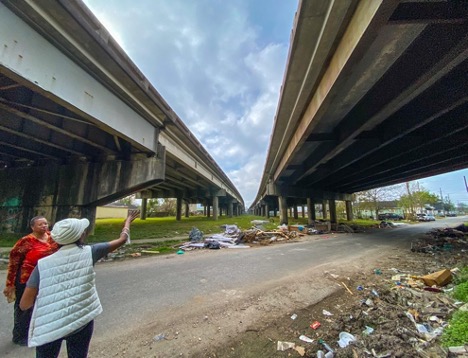 Community leads Amy Stelly and Tamah Yisrael pointing out the I-10 corridor in the 7th Ward, New Orleans. Their organization, Claiborne Avenue Alliance, worked with Thriving Earth Exchange to evaluate the impacts of Highway I-10 that runs above Claiborne Avenue. Their work contributed to a national conversation with New Orleans at its center.
Community leads Amy Stelly and Tamah Yisrael pointing out the I-10 corridor in the 7th Ward, New Orleans. Their organization, Claiborne Avenue Alliance, worked with Thriving Earth Exchange to evaluate the impacts of Highway I-10 that runs above Claiborne Avenue. Their work contributed to a national conversation with New Orleans at its center.
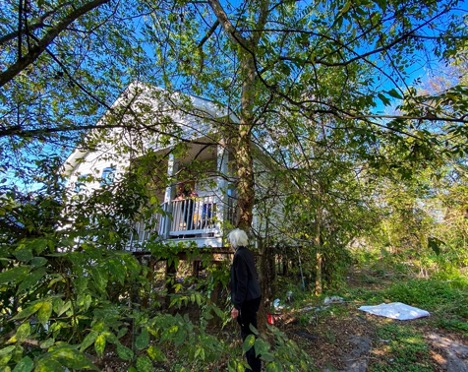 Visiting flood-affected homes in the 9th Ward, New Orleans, with community lead Beth Butler. Raising homes on stilts like this protects them from floods; the lot next door will be developed into a rain garden and bioswale to provide further flood protections and beautify the neighborhood.
Visiting flood-affected homes in the 9th Ward, New Orleans, with community lead Beth Butler. Raising homes on stilts like this protects them from floods; the lot next door will be developed into a rain garden and bioswale to provide further flood protections and beautify the neighborhood.
Julia Kumari Drapkin is the executive producer and founder of iSeeChange.org. She is a radio, television, and multimedia producer based in New Orleans with a passion for finding innovative ways to connect people to their environment and to each other. iSeeChange was born out of covering natural disasters and climate change science across the globe and in her own backyard. Drapkin has worked as the Senior Science Reporter for The Nature Conservancy; a foreign correspondent and environmental radio reporter for PRI’s The World and Global Post in South America; as a photojournalist for the Associated Press in South Asia and the St. Petersburg Times; and most recently as a multimedia producer for the Times Picayune.
Brandon Edwards’ background is in coastal, aeolian and floodplain geomorphology, coastal and wetland hydrology, and remote sensing. His research focuses on studying geomorphic and hydrologic processes to better understand landscape development, the role of physical processes in ecosystem function, and how natural and anthropogenic modifications drive change. Brandon has been with the School of Renewable Natural Resources at the Louisiana State University Agricultural Center since 2011 and is currently on contract as a Coastal Geomorphologist with the U.S. Army Corps of Engineers Environmental Lab working on projects to improve coastal restoration strategies.
Brendan Yuill is a research scientist with the non-profit, the Water Institute of the Gulf. His research interests span engineering geomorphology and watershed hydrology using both field-based and numerical methods. Recently, he has worked on projects relating to coastal restoration along the Gulf Coast with focus on land building sediment diversions and managing the impact of sand dredging on rivers. He is particularly interested in developing novel data streams useful for long-term, low-cost environmental monitoring. Brendan holds an adjunct position at Tulane University and received his PhD in watershed management and ecohydrology at the University of Arizona.

(c) 2024 Thriving Earth Exchange